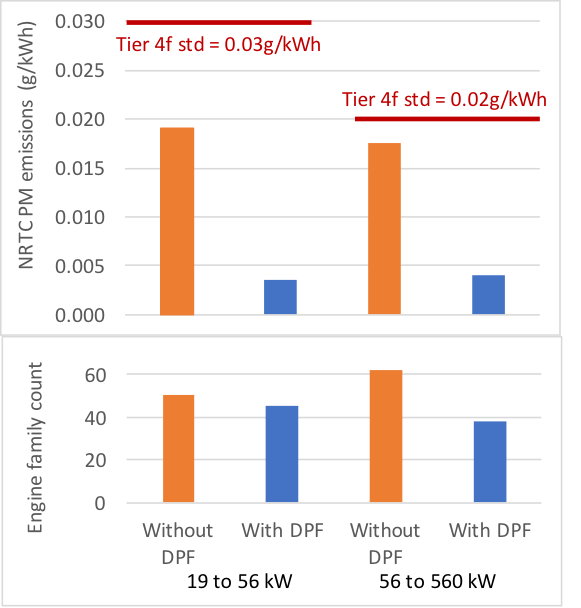Evaluation of emission-control scenarios for agricultural tractors and construction equipment
Blog
China IV non-road standards: A golden opportunity to advance stringent limits and mandate filters
China’s 13th Five-Year Plan on Ecological & Environmental Protection, released on December 5, 2016, indicates that China will accelerate the design, revision, and implementation of emission standards for non-road vehicles (e.g., agricultural tractors, loaders, and excavators), and specifically encourages the implementation of the China IV non-road emission standards before 2020. This presents China with a golden opportunity to develop a set of state-of-the-art emission standards as the updated China IV, with integration of the emission limits (including covering a broad range of engine sizes) defined in the U.S. Tier 4 final non-road emission standards, along with a mandate of using diesel particulate filters (DPFs) on non-road equipment.
Up to now, particulate matter (PM) and nitrogen oxide (NOx) emissions from non-road vehicles in China have been regulated by the China III emission standards, but they are far from enough. The China III and existing China IV emission standards are equivalent to European Union (EU) Stage IIIA and IIIB standards, which were developed and implemented in Europe about a decade ago. The experience in Europe proved that the emission limits of those standards, and even the limits of the next phase—the EU Stage IV standards—are not stringent enough to force implementation of the after-treatment package of DPF and selective catalyst reduction (SCR). The same situation occurred in the U.S., when the Tier 4 final standards did not force the adoption of the after-treatment package on the non-road equipment, as they were expected to do. Data in the U.S. and EU indicate that the non-road sector (agricultural and construction equipment) remains a dominant source of mobile-related air pollutant emissions; these vehicles contributed over 16% of NOx and 40% and 25% of PM emissions, respectively, in 2011.
Another difficulty in regulating the non-road market is the wide range of engine sizes involved. Engines used in hand-held garden equipment can be smaller than 8 kW; engines used in the mining sector can be larger than 560 kW. Regulations on smaller engines are especially important for China, because agricultural equipment powered by engines smaller than 19 kW comprise a considerable share of the non-road market. By following the U.S. Tier 4 final standards, China can consistently regulate these smaller engines, as well as larger ones (>560 kW) to avoid the loopholes identified in the equivalent EU standards, where smaller and larger engines are currently not regulated.
Even though the U.S. Tier 4 final standards cover a wide range of engines, they are still relaxed in PM control. Our recent study found that about two thirds of the manufacturers of non-road engines in the U.S. have managed to adopt cheaper packages to comply with the PM requirements in the Tier 4 final standards, as presented in Figure 1 (bottom panel). Although all engines are in compliance with current PM emission limits, engines without DPFs emit approximately 4 to 5 times as much PM as comparably sized DPF-equipped engines (Figure 1 top panel). Thus, the PM emissions of non-road equipment will likely exceed the required limits after several years of use due to deterioration. By then, the equipment will become gross polluters in the non-road fleet and will contribute disproportionately high emissions.

The upcoming non-road emission standards from the EU, the Stage V emission standards, notably introduce particulate number limits in addition to the tightened PM limits to address the loophole that some manufacturers exploit—avoiding DPF adoption. This set of world-class standards is expected to be the one to finally put DPF and SCR together on non-road equipment. The adoption of a DPF combined with the use of SCR is one of the most effective after-treatment packages for controlling PM and NOx emissions from non-road vehicles; the package is already widely applied to on-road diesel vehicles in the EU, U.S., and many other countries. However, because the Stage V standards will not be in place until 2019 in Europe, it will be a few years before we can verify their effectiveness in requiring the DPFs.
In China, non-road vehicles contribute a similar amount of emissions of PM and NOx as on-road vehicles. China recently committed to major improvements in controlling emissions from on-road vehicles when it released the China 6 emission standards for light-duty vehicles at the end of 2016. The new China 6 combines best practices from the latest emission regulations in the EU, the State of California, and the U.S., and addresses the unique driving conditions in China. The new China VI heavy-duty vehicles emission standards are also on the way. These advanced on-road standards will significantly reduce emissions, improve air quality, and avoid premature deaths, and both PM and NOx will be greatly reduced despite the quickly expanding vehicle market. Consequently, emissions from the non-road sector will soon become the dominant source of PM and NOx in China because of the fast-expanding market and lack of stringent emission standards for non-road vehicles.
To lead the way in effectively controlling emissions from non-road vehicles, it is crucial for China to advance the China IV standards, as more stringent requirements on emissions will always lead to more advanced emission control technology. Thus, China would be wise to adopt the combination of the Tier 4 final emission standards (including covering non-road equipment of all sizes) and DPF requirement directly as the new China IV emission standards to effectively control PM and NOx emissions.
